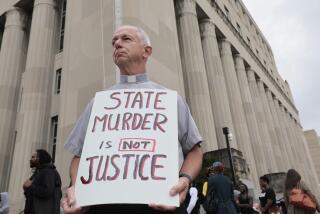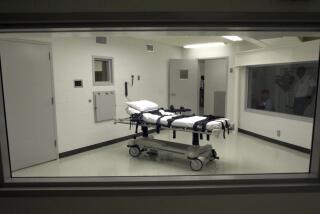Killer Seeking Electrocution Death Executed by Injection
LUCASVILLE, Ohio — A convicted killer who once chose the electric chair for his death to protest capital punishment was executed by injection Tuesday despite his claim that an accomplice committed the stabbing for which he was condemned.
John W. Byrd, 38, was sentenced to die for the 1983 murder of Monte Tewksbury, 40, who was stabbed during a robbery at a convenience store outside Cincinnati where he was moonlighting to pay for his daughter’s education.
“He said the state shall fall and the rest of you, you know where you can go,” television newswoman Teri Barr, a media witness to the execution, quoted Byrd as saying.
“Monte is at a place where he could speak of forgiveness and mercy to the man who took his life. I cannot,” said Tewksbury’s widow, Sharon.
Byrd insisted he could not remember what happened because he was under the influence of drugs and alcohol. An accomplice, John Brewer, confessed to stabbing Tewksbury.
But prosecutors said Brewer was lying to protect Byrd. Brewer was already serving a life sentence and could not be retried.
Byrd chose the electric chair as his method of execution, first scheduled for last September, to demonstrate the brutality of the method, which has not been used in Ohio since 1963. But Ohio banned the chair in November, leaving lethal injection as the sole means of execution.
The last electrocution in the United States, of Michael Claggett in Virginia July 6, 2000, was one of five that year. All 108 U.S. executions since have been by lethal injection.
Gov. Robert A. Taft denied clemency for Byrd last week.
A federal appeals court and the U.S. Supreme Court rejected his last-minute appeals.
His fight to avoid execution exposed an unusual rancor among judges in the 6th U.S. Circuit Court of Appeals, who accused each other of holding secret meetings and engaging in questionable tactics to spare Byrd.
More to Read
Sign up for Essential California
The most important California stories and recommendations in your inbox every morning.
You may occasionally receive promotional content from the Los Angeles Times.










